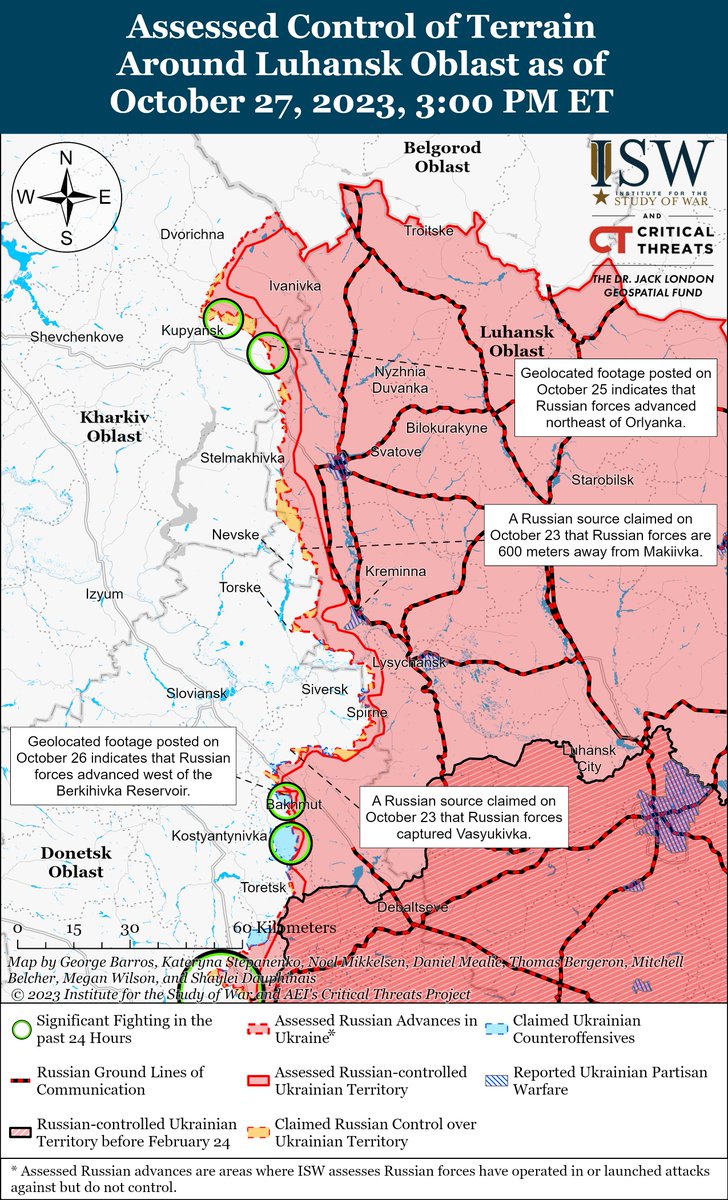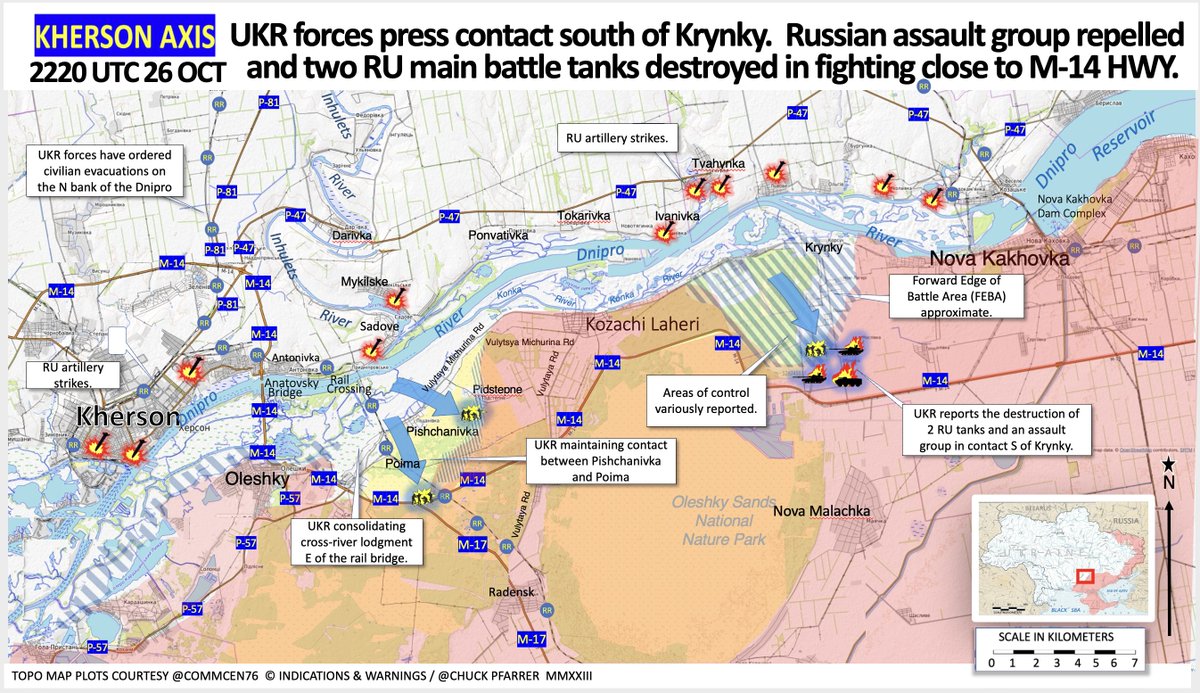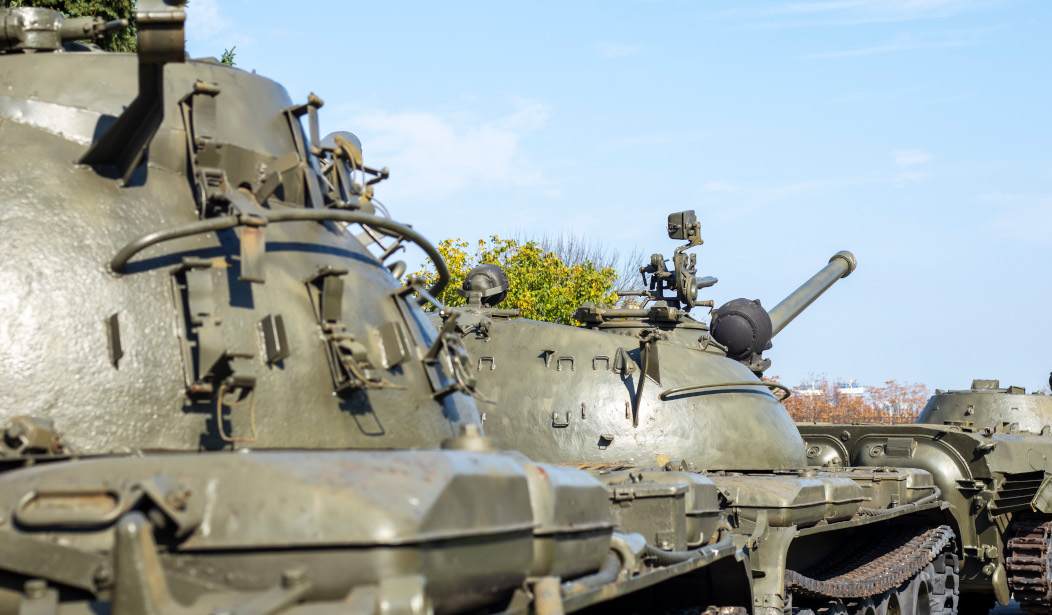Here we are again, over 600 days into Putin's leisurely three-day jaunt to Kiev. Sorry for the delay. I'd like to tell you I was pursuing some big story but I wasn't. We've had a few gorgeous, 80-degree days here in the highlands, and I made the most of the time outside.
This week seemed to confirm that the war is winding down for a short while. There is still a lot of ferocious combat going on, but it is on a local level and unlikely to yield much in the way of operationally or strategically useful gains. The main battleground shifted from Ukraine to Washington this week with the election of a new, Ukraine-skeptical House Speaker, Louisiana's Mike Johnson (Republican Mike Johnson Elected Speaker of the House and A True Conservative Speaker). How Johnson handles funding for Ukraine will either make Putin look for a way out or it will encourage him to hold on and bet that he can outlast Ukraine's supporting coalition.
The big challenge for Johnson, in addition to trying to keep a House majority, will be addressing the decrepitude of the US military industrial base and the sad shape of the US Navy. His response to Ukraine will give us a hint on how he will handle this problem.
Politico-Strategic Level
Good Help is Hard to Find
Last week, the Ukrainian military targeted two Russian airfields in Occupied Ukraine with newly arrived ATACMS missiles (Putin's War, Week 86. The Very Resistible Force Meets the Immovable Object in Donbas and Russia Claims US ATACMS Missiles Hit Two Airbases in Occupied Ukraine). An estimated 21 helicopters were destroyed or damaged. As a result, helicopters have been moved to bases outside the reach of the version of ATACMS used by Ukraine. The Russians have also begun placing decoy aircraft to draw fire. While the concept was good, the execution seems to have been quintessentially Russian.
Good Information to Have in an Antisemitic, Nazi-like Kind of Way
Things That Make You Go Hmmmm...
There was no suggestion of foul play, but then again, there never is.
The OSINT Ecosystem Collides With Journalism, and the Result Is Ugly
Open Source Intelligence, or OSINT, is the mainstay of factual reporting about the war in Ukraine. The credible accounts are devoted to accuracy, not a narrative, and remain true to that credo even when the results are not what they like. Without sites like Oryx meticulously geolocating every video/image verified loss and evaluating the severity of the damage, we would be at the mercy of mathematical illiterates in the nation's newsrooms. Thanks to Twitter (under Elon Musk because Jack Dorsey's leftist abomination would never have permitted it), anyone with the ambition could get high-quality loss data and unit positioning for free.
Unfortunately, newsrooms figured out the same thing. Now, three of the top-notch OSINT sites have folded. Oryx and UAWeapons have said little beyond it had stopped being fun, and they could not continue producing quality work for free. Calibre Obscura is much more specific. While news organizations were willing to copy its work without attribution—as the former proprietor of the top conservative blog in Maryland (low bar, I know, I know), I can tell you our stories were routinely used without attribution by papers whose names you would recognize—they were not willing to offer employment of contract work. Read the post.
This is a loss to the public's knowledge of what is happening in Ukraine and makes everyone more reliant on the press-release journalism that dominates war coverage today.
Perception of Corruption
One of the most tired and ridiculous arguments leveled at our support of Ukraine is that Ukraine is corrupt. As I've pointed out before (Week 86. The Very Resistible Force Meets the Immovable Object in Donbas), Ukraine does have a corruption problem, but it is less corrupt than Putin's Russia. While Ukraine is making measurable progress against corruption, Russia is becoming more corrupt. None of that matters. If Russia were Plato's ideal of a state, that still would not excuse its invasion of a neighbor or presuming to control a sovereign state's foreign and domestic policy.
I stumbled across this interesting thread on Ukrainian public opinion on the state of corruption. The top line is Ukrainians realize there is a corruption problem, but half perceive the Zelensky government as fighting corruption "rather effectively." Even among the minority that see no progress, 66% oppose concessions to Russia to end the war. The messages are 1) Ukrainians know corruption exists, 2) the Zelensky government is seen as making a lot of progress, and, most importantly, 3) Ukrainians don't want to give any land to Russia for peace.
The Wise Russian Man-in-the-Street
This interview is a classic. In a society where giving the wrong answer in an interview, giving the correct answer convincingly is a vital evolutionary skill.
Things have not changed much since Aleksandr Solzhenitsyn's 1974 essay, "Live Not By Lies."
Yes, at first it will not be fair. Someone will have to temporarily lose his job. For the young who seek to live by truth, this will at first severely complicate life, for their tests and quizzes, too, are stuffed with lies, and so choices will have to be made. But there is no loophole left for anyone who seeks to be honest: Not even for a day, not even in the safest technical occupations can he avoid even a single one of the listed choices—to be made in favor of either truth or lies, in favor of spiritual independence or spiritual servility. And as for him who lacks the courage to defend even his own soul: Let him not brag of his progressive views, boast of his status as an academician or a recognized artist, a distinguished citizen or general. Let him say to himself plainly: I am cattle, I am a coward, I seek only warmth and to eat my fill.
(In fairness, we faced, and largely lost, the same struggle over COVID-19 and January 6.)
Operational Level
New Weapons
Something Old, Something New...
I've posted before on obsolescent HAWK antiaircraft missiles being pulled out of storage and sent to Ukraine; see Week 33. Mobilization Muddle, a New Era in Air-to-Air Combat Begins, and Another Lull Before a Storm and Week 68. The Offensive Develops, Cracks Emerge, and Never Forget the Enemy Has a Vote. This is the first video of one in action; the target is a Russian Orlan drone.
Much of the target array in the Ukrainian battlespace can be engaged and killed by weapons sitting in depots awaiting demilitarization. A lot of the weaponry sent by the West, whether it be M113s about to be sold to scrap vendors for literally $1 each or Stinger antiaircraft missiles, are proving their value in Ukraine.
New Russian Howitzer
The Russian military says the Rostec 2S43 Malva (this has echoes of a Seinfeld episode) 155mm self-propelled howitzer has been delivered. This is a knockoff of the French CAESAR, Swedish Archer, and Ukrainian Bohdana. We'll know more about it when it enters combat.
Combat Operations
More on Avdiivka
Last week, I went into a lot of detail on the spectacularly unsuccessful Russian attack on the Ukrainian salient at Avdiivka. This video has appeared with some excellent analysis along with the imagery. The Russians attacked in a single column or a mine-roller tank and two tanks leading a column of infantry fighting vehicles (IFVs). The Ukrainians hit the leading IFV with a drone, separating the infantry from the armor. When the mine roller tank reached a treeline, it turned around and went home. Significantly, the other tanks went with it, showing this was not a combined arms team, but rather two different units with different missions. As the tanks departed, the Ukrainians went to work immobilizing the IFVs and, when the infantry dismounted, engaging them with artillery, including cluster munitions.
The fact that this could happen 18 months into the war shows the cost you pay by not rotating experienced officers and soldiers to training billets.
Refit and Retrain
There is increasing evidence that some of Ukraine's most capable brigades are being pulled from the line for refitting and retraining.
There is also evidence that some Russian units have been pulled out of the line for rebuilding rather than the usual process of feeding raw replacements into units and having them learn by doing.
Amateurs Talk Tactics, Professionals Talk Logistics
This lesson was beaten into me at the Infantry Officer's Basic Course: It doesn't matter what kind of an operational concept you develop unless you have the logistics to support the troops and sustain their ability to maneuver. Case in point: Monday, Russian Defense Minister Sergei Shoigu told the Imperial Russian Senate that the Russian Army in Ukraine gets 10-15 thousand tons of supplies per day.
"To understand the scale, we supply 1,500 tons of water to the armed forces every day - this is only drinking water. We wash about 350 tons of laundry per day. That is, it must be understood that everything is not happening in one place. This is on a huge front line, which, if we take it in general, we have more than 1,000 km," Shoigu stressed, noting that "all this, of course, must be managed, supplying the armed forces with up to 10,000 tons of various materials per day, and sometimes up to 15,000 tons of various materials per day." "It's ammunition, fuel. Everything related to the production of repair and maintenance of equipment," he added.
Sounds impressive, but what does it mean?
Let's take tanks for example, a T-72 needs 1,287kg of ammunition for it's main gun for a full combat load of 39 rounds. It also required 1,200L of fuel or roughly 1,020kg per tank. This does not include the optional external fuel tanks.
On the Kupyansk to Kreminna there are 51 units that use tanks going off of @projectowlosint maps. If these unit's were at 100% equipment (likely not) that would be 2,322 tanks.
To fully supply these tanks with 1x combat load would require 2,998,414kg of 125mm ammunition, and 2,368,440kg of fuel. This works out to 3,305.18 tons of ammunition, and 2,610.75 tons of fuel. For a total of 5915.93 tons just to supply the tanks this axis.
Even at 50% strength we would still be looking at 2,957.96 tons just for the tanks. Add in 931.51 tons of small arms ammunition, 3.8 tons fuel for their AFV's, 3,564 tons of 152mm ammo for SPG's, 887 tons for their fuel. It all adds up very quickly to 8,691.49 tons.
This is just one front and not even including ammunition of AFVs, towed arty, rocket arty, etc. To even hover around the 15,000 mark, the Russian armed forces would need to be between 30%-40% effective strength.
In conclusion, while to the Russian public the number might sound impressive, it doesn't not cover any of the needs of the Russian armed forces in Ukraine, and is likely a made up number, or a sign the Russians are truly in trouble.
The Russian Army needs about four times the rate of supply that Shoigu boasts about to function. This doesn't account for supplies lost to attack and spoilage. The analysis is also based on a deceptive headline. The headline boasts of 10-15,000 tons of fuel and ammunition daily when Shoigu is clearly talking about all classes of supply, with 10,000 tons per day being the norm and 15,000 tons per day as surge capacity.
Better Lancets?
The Lancet suicide drone has kept the Russian Army in the battle. Its strikes against Ukrainian logistics, indirect fire, and electronic warfare targets have been critical. The downside is that it doesn't seem all that accurate. We've seen a lot of videos where a Lancet makes a glancing strike or misses entirely. According to reports, the Lancet guidance system is undergoing an upgrade to improve accuracy.
Calling B******t
Perhaps smarting from the embarrassment suffered by the Russian Air Force at the hands of ATACMS missiles, Defense Minister Shoigu fell back on the most Russian tactic possible: the Big Lie.
This didn't happen. There is no video proof of this claim. More tellingly, none of the quasi-official milbloggers on Telegram have reported anything like this. Curiously, 24 is the upper end of the estimated number of Russian helicopters caught in the ATACMS strikes.
Tactics, Techniques, and Procedures
How Not to Organize an Attack
I posted a shorter version of this video last week. It took place during the repeated Russian assaults on Adiivka. The dark line is caused by a tank with a mine-roller. The mine roller has two escort tanks. The action starts with the Ukrainians taking out the leading IFV with a drone. The mine roller and escorts leave the battlefield, leaving the infantry unit on its own.
Here is another example of everything going wrong.
And another.
New Driver. Please Be Patient
Drone Defense
More and more vehicles and positions sport large expanses of netting to defeat suicide drones. Here's how they work.
Northern Front
Kharkiv

Fighting continues in this sector. The Russians have made small gains, but so have the Ukrainians.
Donbas

Fighting continues, but the intensity of the last two weeks has decreased. There are reports of Ukrainian forces in some sectors of this area laying minefields, which would indicate that offensive operations have ended for the season.
Bahkmut-Klishchiivka-Andriivka
The Ukrainian Army retains the initiative in this area of operations with its focus on enveloping Bakhmut from the south. There were unsubstantiated reports of progress in penetrating the Russian line at Klishchiivka.
Adiivka
The Russian attacks on the Avdiivka salient continued but at a slower pace. The Russians have gained some territory on the north side of the salient. In my opinion, the salient is not in danger unless there is a moral collapse of the defenders.
Headquarters Hit by HIMARS
Follow-up On ATACMS Strike
Last week, the Ukrainians announced they had been given the Army Tactical Missile System (ATACMS) by hitting two airfields in Donbas (Russia Claims US ATACMS Missiles Hit Two Airbases in Occupied Ukraine).
In addition to impact craters, you can also see tire tracks in the asphalt. This is not a good thing.
Commercial satellite imagery shows 21 helicopters destroyed or damaged. This is roughly 10% of the known Russian helicopter fleet in the theater.
New ATACMS Strike
Two S-400 surface-to-air missile sites were destroyed.
Southern Front
Zaporizhzhia
Some intense combat is reported. The Ukrainians are continuing to push in areas where they have experienced success.

Robotyne-Verbove- Novoprokopivka
Ukraine made minor progress. It continues to try to widen the western shoulder of the salient by attacking in the direction of Kopani. At the same time, it is increasing the size of the breach in the Suvorovikin Line west of Verbove. I
Kherson
The Ukrainian offensive on the left bank of the Dneiper River continues to gain momentum. The Russians are handicapped by a lack of troops and superior Ukrainian artillery that keeps Russian reinforcements from moving up. As yet, the Ukrainians have not pushed a ribbon bridge across the river. Until 3 or 4 of these are in place, the offensive will be light infantry moving slowly.

Be sure to give former SEAL platoon leader Chuck Pfarrer a follow; he does excellent work.
Rear Areas
Crimea
Your Guess Is As Good As Mine Department
It's hard to say what this means right now. It could be an accident on board, but the Sevastopol roadstead is not a safe place for Russian ships.
What's Next
The campaign season seems to have ground to a halt for 2023. A lot of fighting remains to be done, but the prospects of big gains are minimal. The wild card in the deck is the moral strength of both armies. This is a grueling war where both sides have decided that attrition is preferable to maneuver. My gut feeling is that the Russian Army will show significant signs of cracking by spring. There are already rumors of "combat refusals" and desertions on a scale that has Moscow's attention.
Militarily, I think Ukraine will move into next year in good shape. Contrary to a lof of people who should know better, there is no evidence of an inability to fill the ranks. The number of Ukrainian celebrities in the ranks undoubtedly aids the "we're in this together" feeling. ATACMS is coming into service. F-16 pilots have started training. Repair facilities appear to be working. The only possible hiccup is the supply of artillery ammunition, but 14 nations are now producing 155mm ammunition for Ukrainian guns. It will definitely enter the new campaigning season in much better shape than the Russians.
The wild card is the political environment in the US and Europe. If the coalition that was built in 2022 holds, there are good prospects for substantial progress in the spring. If the logistical and economic support for Ukraine wanes, then we'll have to see what happens.

